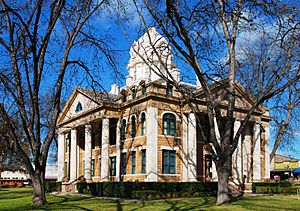Fisher–Miller Land Grant facts for kids
The Fisher–Miller Land Grant was a huge piece of land in early Texas. It was part of an effort to get people to move to and settle in the Republic of Texas (which was an independent country before it joined the United States). This land grant covered about 3,878,000 acres, which is like 5,000 square miles (13,000 km2)! It was located between the Llano River and the Colorado River.
The land was first given to two men, Henry Francis Fisher and Burchard Miller. But they later sold it to a German company called Adelsverein. Not many people ended up settling directly on this land grant. Most settlers chose to live in towns like Fredericksburg and New Braunfels, which were outside the grant's borders. Today, you can find a special granite monument near Lookout Mountain in Burnet County. It tells the story of the Fisher–Miller Land Grant and was recognized as a Recorded Texas Historic Landmark in 1964.
Contents
Where Was the Fisher–Miller Land Grant?
The Fisher–Miller Land Grant was so big that ten different counties were later formed from its territory. These counties are:
Texas Land Grants: How They Worked
The Republic of Texas used to give out land grants to individuals or groups. The idea was that these people would help settle new areas of Texas. But there were rules! The people who received the grants had to establish settlements in a specific area. They also had a limited time to do it. If they didn't, they could lose the grant.
Fisher and Miller's Big Plan
On February 8, 1842, Henry Francis Fisher, Joseph Baker, and Burchard Miller asked the Republic of Texas for a land grant. They were part of a group called the San Saba Colonization Company. On June 7, 1842, Fisher and Miller officially received the land grant. Their job was to bring 1,000 immigrant families to Texas. These families were supposed to be from Germany, Holland, Switzerland, Denmark, Sweden, and Norway.
This huge land grant was called the Fisher–Miller Land Grant. It covered about 3,878,000 acres (5,000 square miles or 13,000 km2) between the Llano River and the Colorado River. This area was known as the Comancheria, which was the hunting ground of the Penateka Comanche Native Americans. Fisher and Miller didn't have much luck getting people to settle there at first. But they were able to get more time to complete their contract.
The Adelsverein Steps In
Fisher and Burchard Miller sold their land grant to a German company called the Adelsverein on June 26, 1844. Fisher and Miller knew that settling in the Comancheria was dangerous because of the Comanche people living there. However, they didn't tell the Adelsverein about these dangers. The Adelsverein also agreed to pay for the expenses of the San Saba Colonization Company. Henry Fisher even became part of the Adelsverein's colonial committee.
The first leader of the Adelsverein, Prince Carl of Solms-Braunfels, didn't have any success settling the land grant. So, the job went to his successor, John O. Meusebach. Meusebach was much more successful. He managed to make a peace treaty with the Penateka Comanche in 1847. This was a big deal because it was a non-government treaty, meaning it wasn't made by the official government.
The Darmstadt Society of Forty
The Darmstadt Society of Forty was a group of German settlers. Two of their founders, Hermann Spiess and Ferdinand Ludwig Herff, met with a leader from the Adelsverein. They made a deal to bring 200 families to settle on the Fisher–Miller Land Grant. In return, they would receive money, animals, equipment, and food for a year. After that first year, the settlements were expected to support themselves.
A guide named Emil Kriewitz helped these settlers travel through the land grant. They tried to start several colonies, including:
- Castell
- Leiningen
- Bettina
- Schoenburg
- Meerholz
These were all in Llano County. They also tried to start Darmstädler Farm in Comal County and Tusculum in Kendall County. Out of all these attempts, only Castell and Tusculum (which later became the town of Boerne) still exist today.


